
by Stephanie Luke
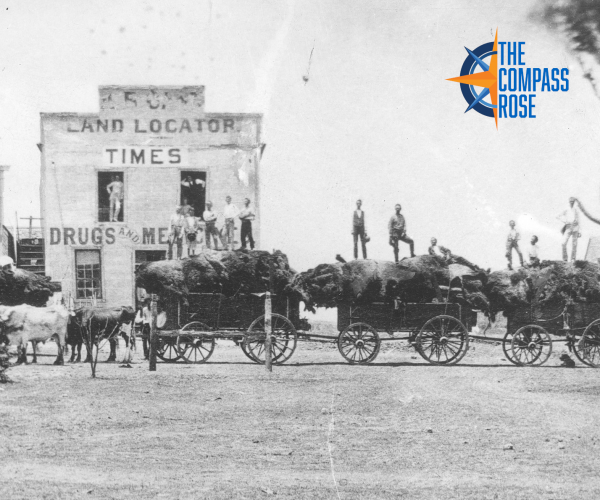

by Stephanie Luke
The purpose of The Compass Rose is to raise awareness of Special Collections' resources and to foster the use of these resources. The blog series also reports significant new programs, initiatives, and acquisitions of Special Collections.
This Earth Day, we look back at William T. Hornaday, a prominent figure in the early conservationist movement who played a pivotal role in bringing attention to the decimation of the American buffalo.
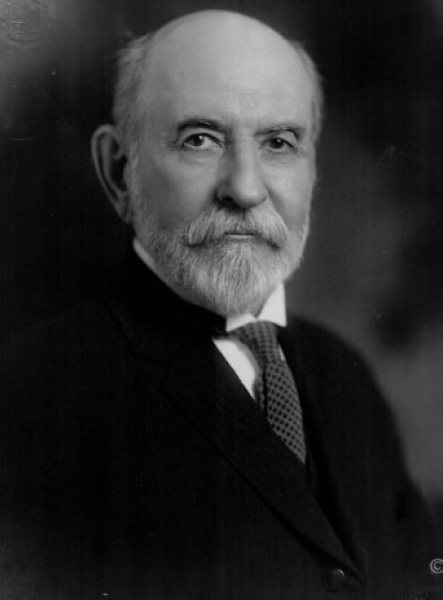
Portrait of William Temple Hornaday. Courtesy of Wikipedia.
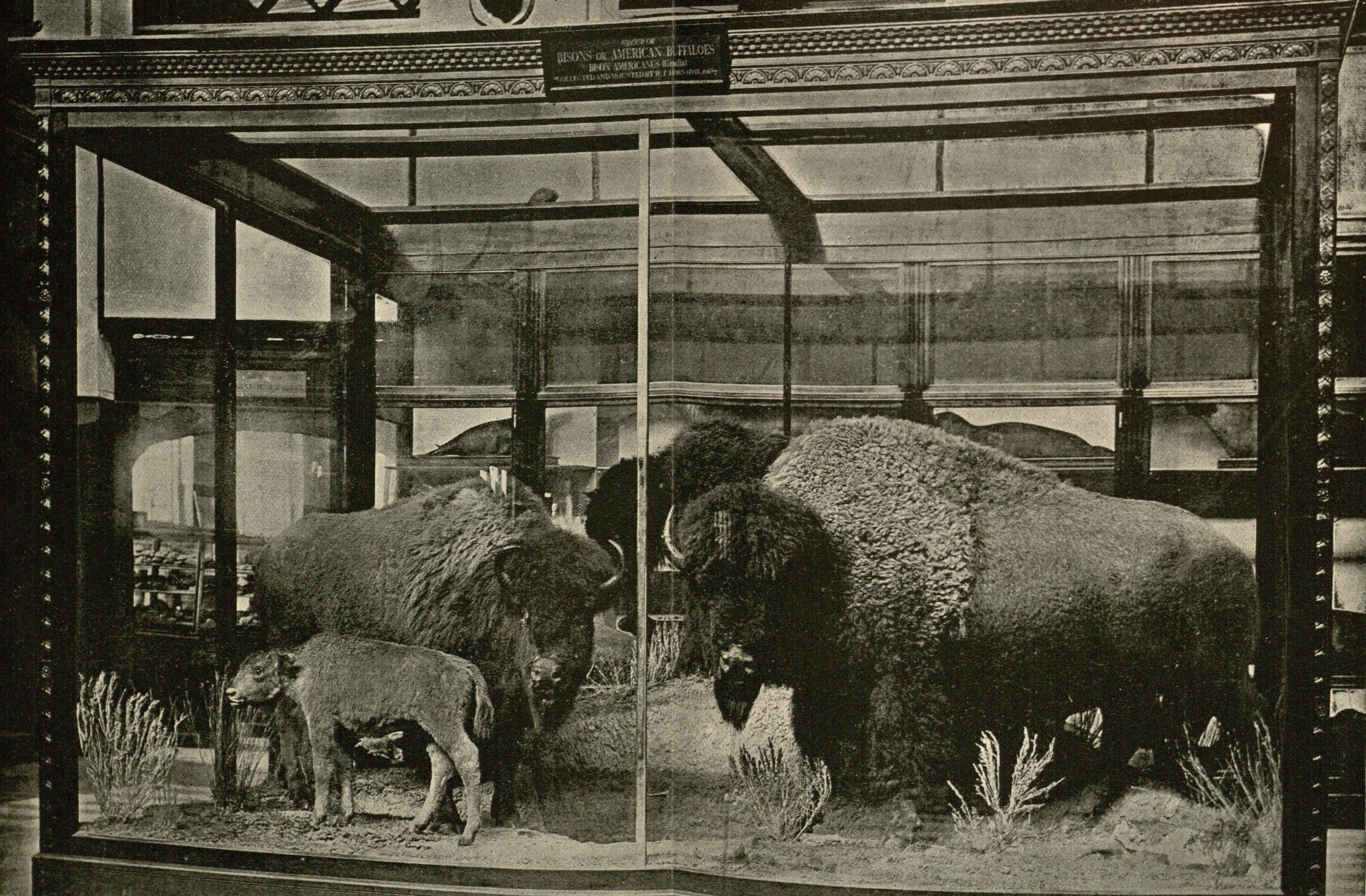
Three taxidermy buffalo, collected and mounted by Hornaday, on display at the Smithsonian. The frontispiece of the Extermination of the American Bison.
By the end of the nineteenth century, the buffalo, once so plentiful in the American West, had been hunted almost to extinction. In 1886, the Smithsonian Institution sent a team of naturalists to Montana to gather specimens before the species disappeared altogether. William T. Hornaday, the chief taxidermist at the Smithsonian, led the expedition. Hornaday’s observations were published in the institution’s annual report for 1886-87.
In 1889, Hornaday reprinted his report as the Extermination of the American Bison. He prefaced the work with the following words: “The wild buffalo is practically gone forever, and in a few more years, when the whitened bones of the last bleaching skeleton shall have been picked up and shipped East for commercial uses, nothing will remain of him save his old, well-worn trails along the water-courses, a few museum specimens, and regret for his fate.” His statement was supported by the count of the species taken earlier that year. The numbers were dire: there were only 256 animals in captivity and one protected herd of about 200 animals in Yellowstone.
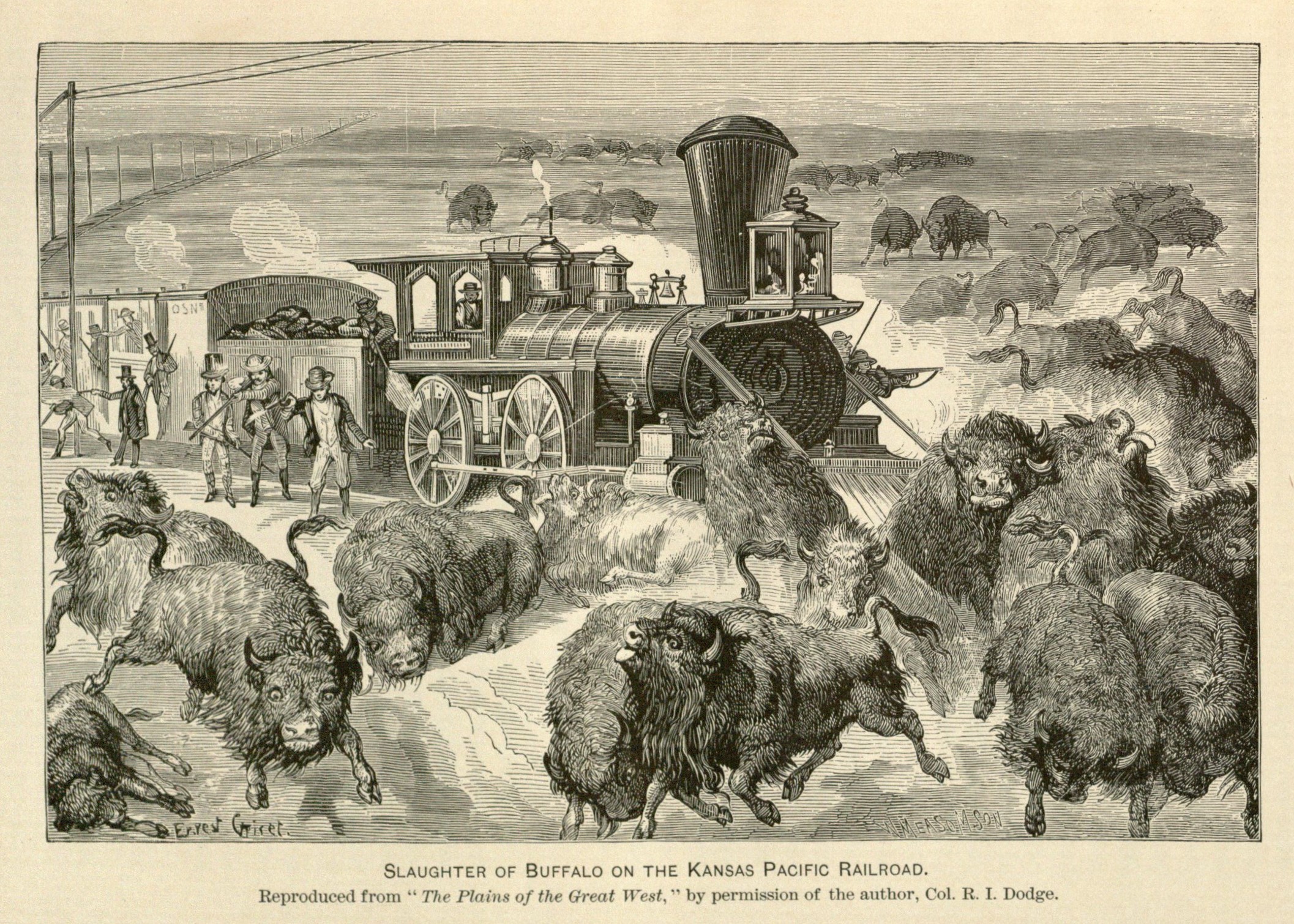
The transcontinental railroad facilitated the systematic slaughter of buffalo. This reproduction of R. I. Dodge’s painting “The Plains of the Great West” shows men shooting the animals from the train. From the Extermination of the American Bison.
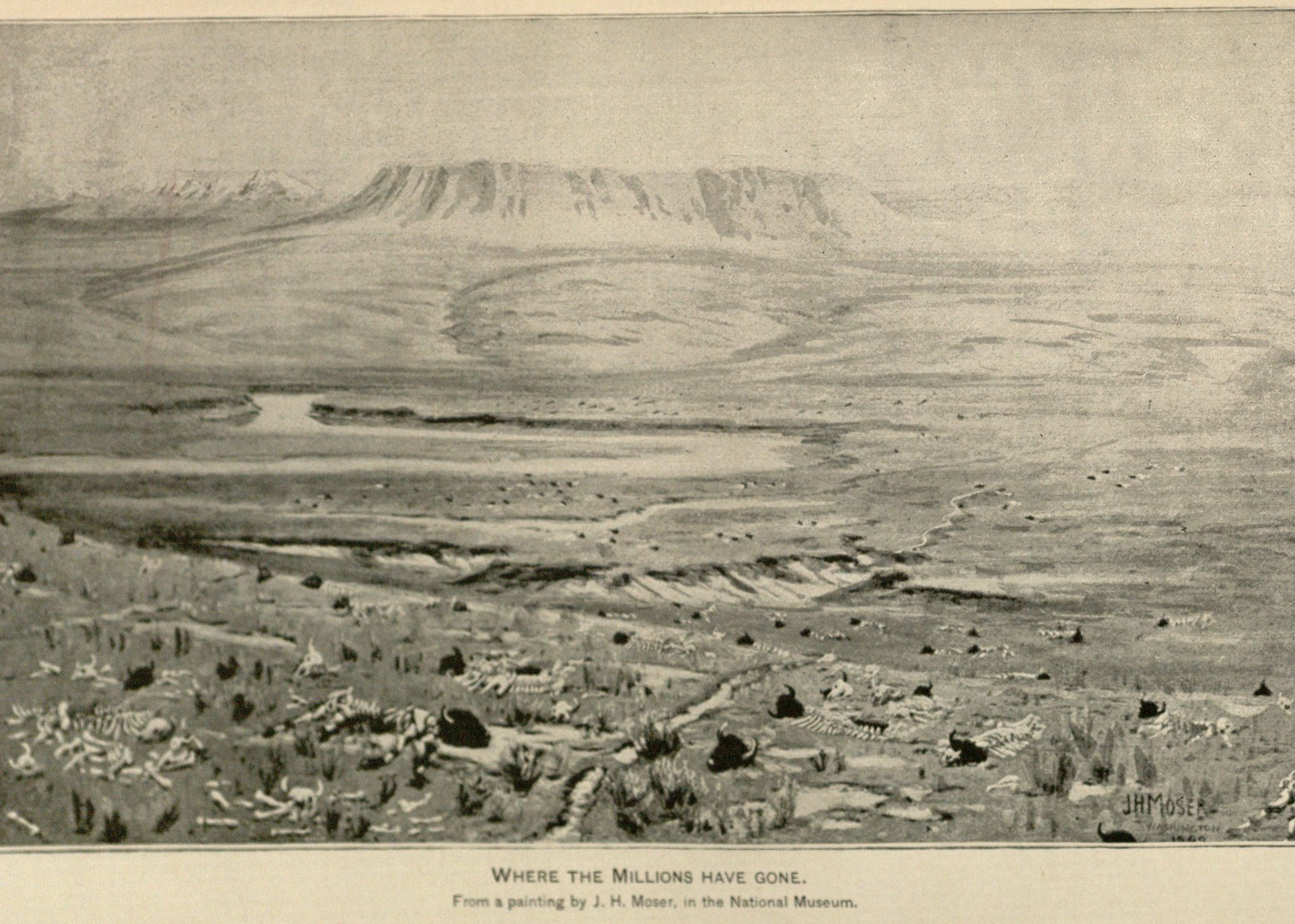
In this reproduction of the J. H. Moser's painting “Where the Millions Have Gone," the plains are empty of anything other than buffalo bones and carcasses. From the Extermination of the American Bison.
In the nineteenth century, extinction was not a concept that was well-understood. Because of unearthed fossils, scientists were aware that animals that were no longer living had once roamed the earth. For many, however, it was easier to accept the existence of long-dead animals from fossilized remains than to recognize that living species could also meet the same fate. The perception of the natural world and man’s place in it was very much influenced by the humanist, Enlightenment model of the Great Chain of Being, which espoused the completeness and perfection of nature (Rowland 2009, 237). In just the few centuries before Hornaday’s publication of the Extermination of the American Bison, however, a number of species had already disappeared, among them the Auroch (1627), the Dodo (1662), Steller’s Sea Cow (1768), the Great Auk (1852), and the Labrador duck (1875). While many viewed these as isolated cases, individuals like John James Audubon, who began to have difficulty locating specimens of species that were prolific only years before, argued that extinction was a very real threat. (For more on Audubon, please visit Metadata Librarian Stephanie Luke’s post on Special Collections’ acquisition of Viviparous Quadrupeds of North America.)
Hornaday’s success in convincing his audience of the decline of the buffalo may largely have been due to the size and ubiquity of the animal, both of which made its disappearance all the more apparent. When he wrote on the abundance of the buffalo in North America, he declared: “Of all the quadrupeds that have lived upon the earth, probably no other species has ever marshaled such innumerable hosts as those of the American bison. It would have been as easy to count or to estimate the number of leaves in a forest as to calculate the number of buffaloes living at any given time during the history of the species previous to 1870. Even in South Central Africa, which has always been exceedingly prolific in great herds of game, it is probable that all its quadrupeds taken together on an equal area would never have more than equaled the total number of buffalo in this country forty years ago” (Hornaday 1889, 387).
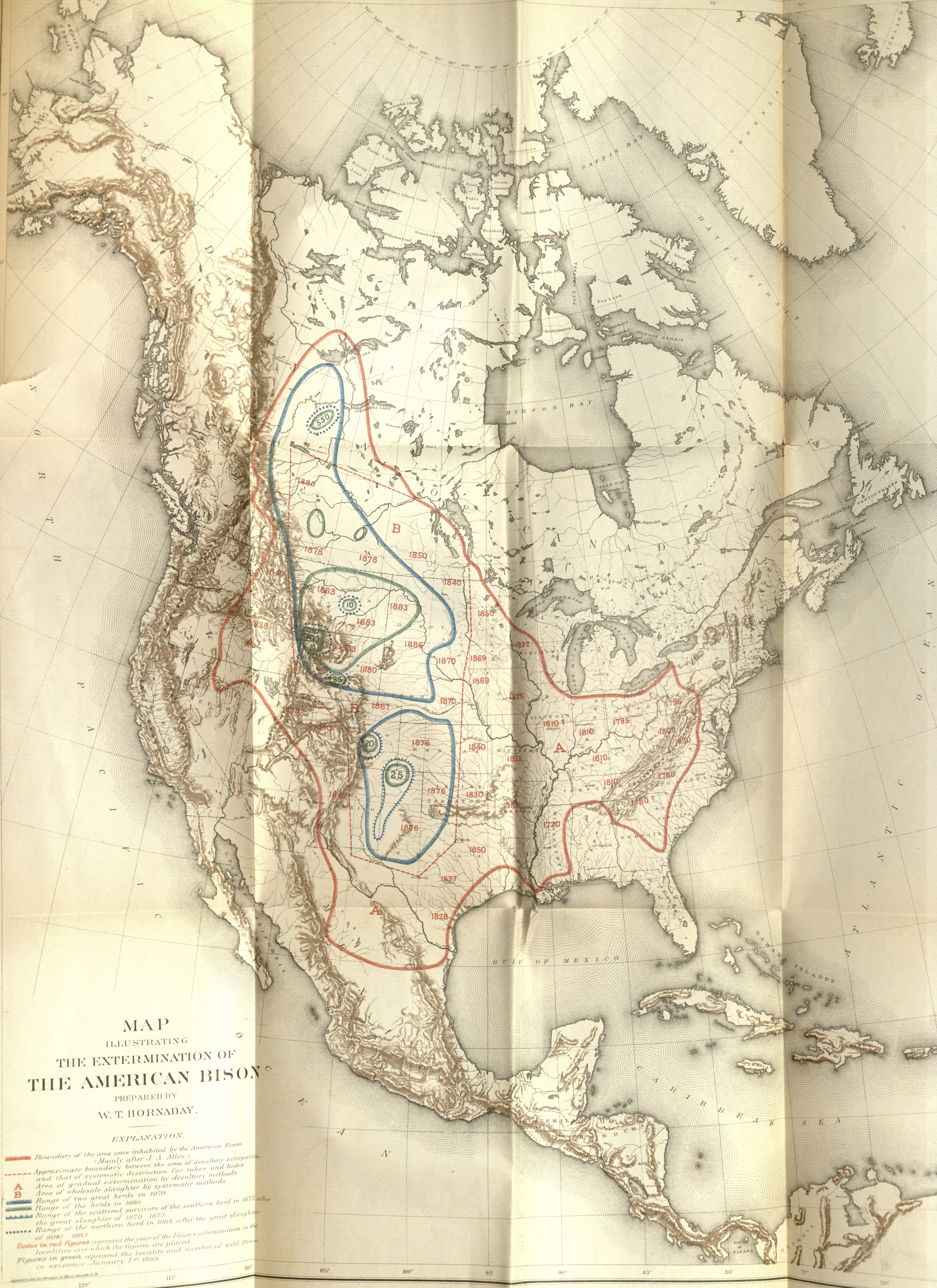
Hornaday included a map in the Extermination of the American Bison that illustrated the shrinking population of buffalo in North America.
In the second part of the work, Hornaday outlined six causes for the buffalo’s thinning numbers: the movement of humans into the animal’s territory, the destructiveness and greed of man, the absence of protective measures and agencies, the preference of hunters for the hides of the female buffalo, the indifference of the buffalo to man, and the technology of modern fire arms. Although Hornaday does not specifically mention it, the transcontinental railroad was key in facilitating the large-scale hunting of buffalo. With the railroad, individuals had greater access to the herds (sometimes even hunting them from inside passenger cars) and could more easily transport hides. The photo below, one of the first taken in Weatherford, Texas, illustrates the sheer number of buffalo killed by commercial hunting. What was perhaps most upsetting, however, was that many times no part of the buffalo was used other than the hide. As one of Hornaday’s contemporaries noted, the animals were often slain “by white hunters and tourists merely for their robes, and in sheer wanton sport, and their huge carcasses left to fester and rot, and their bleached skeletons to strew the deserts and lonely plains” (Baltimore 1889, 515).
Hornaday predicted that the buffalo would be extinct within two decades if conservation efforts were not pursued. In 1905, Hornaday, with the support of President Theodore Roosevelt, founded the American Bison Society whose goal was to create bison sanctuaries and manage the relocation of animals to these protected areas. Today, the current population of buffalo in America is estimated at 350,000, a mere fraction of the number that had roamed the plains before the mid-nineteenth century but a far cry from the near extinction Hornaday encountered.
For the rest of his life, Hornaday continued to raise awareness about extinction. In 1913, he published Our Vanishing Wild Life, in which he argued for measures to be enacted to promote the protection of animals from human destructiveness. He declared that “We are weary of witnessing the greed, selfishness and cruelty of ‘civilized’ man toward the wild creatures of the earth. We are sick of tales of slaughter and pictures of carnage. It is time for a sweeping Reformation; and that is precisely what we now demand.”
Andrei, Mary Anne. “The accidental conservationist: William T. Hornaday, the Smithsonian bison expeditions and the US National Zoo.” Endeavour 29, no. 3 (2005): 109-113.
Baltimore, J. M. “In the Prime of the Buffalo.” Overland monthly and Out West magazine 14, no. 83 (Nov. 1889): 515-520.
Hornaday, William T. The Extermination of the American Bison. Washington, D.C.: Smithsonian Institution/Government Printing Office, 1889.
Hornaday, William T. Our Vanishing Wild Life: Its Extermination and Preservation. New York: New York Zoological Society, 1913.
Rowland, Stephen M. “Thomas Jefferson, extinction, and the evolving view of Earth history in the late eighteenth and early nineteenth century.” In The Revolution in Geology from the Renaissance to the Enlightenment, edited by Gary D. Rosenberg, 225-246. Boulder, Co.: The Geological Society, 2009.
“Science Notes.” The American (New York), May 24, 1890.
Add new comment